
Station Name: TRUMPINGTON The Royal Agricultural Society of England 1922 show [Source: Darren Kitson]
(RAS) began life in 1838 as the English Agricultural Society and took on its more grandiose name a year-or-so later following, apparently, a merger of several smaller but regionally orientated societies. The Royal Show, to use its common and more convenient name, was an agricultural show held every year from 1839 at different locations, including in Britain's larger cities, with gaps during wartime. The shows were to become massive affairs which attracted exhibitors and visitors from all over the country and included not just livestock and horses but the latest in relevant technology, business methods, foodstuffs and so on. Many exhibitors were big names in engineering and displayed and demonstrated agricultural implements, stationary and self-propelled steam engines and, in due course, internal combustion-powered machinery. Later still, communications and computer systems applicable to agriculture were exhibited. Shows usually ran for four or five days depending upon the period and other factors. Commencing in 1968 the show was held each year at Stoneleigh Park, Warwickshire, thus breaking the 129 year-old tradition of moving around the country. The show was held for the final time in 2009 and the semi-permanent site at Stoneleigh Park was thenceforth used as the venue for the Agricultural Buildings Show. The Royal Show has been held on a number of occasions at Cambridge, the first time being in 1840 before the railway arrived in Cambridge, 1894, 1922, 1951, 1960 and 1961. This page is concerned with the 1922 show, held on 4 - 8 July that year on land north of Long Road, Trumpington, and west of the LNWR and for which a railway station was constructed on the land between the GER and LNWR. The latter land, despite being hemmed-in by two railways and a road, was apparently still owned by Trinity College at the time and rented to the GER. The 1951, 1960 and 1961 shows were also held at Trumpington but on land south of Long Road and between the GER and LNWR, the latter curving away westwards at that point allowing the showground to extend as far as Shelford Road. It was these three shows which gave rise to the local road name Showground Road; now residential but for many years past just an unmetalled track. The shows involved the transportation of everything from traction engines to toilet paper, cows to corn, sheds to shovels - you name it. Before the advent of reliable road transport and comprehensive motorway network, the shows very much depended upon the railways and the logistics, to use a word which road hauliers have stolen from the military, of the 1922 show at Cambridge were an absolute masterpiece on the part of the railway companies involved and especially the Great Eastern Railway. The 1922 show was the second occasion concerning Cambridge, the first being 1894, for which details of railway involvement are known. The 1922 show was something of a disappointment in respect of attendances due to adverse weather conditions, but otherwise all went as planned. Trumpington Station and the Showground
The plan (click here for a larger version) above is from the September 1922 edition of Railway Magazine (RM) but with orientation added. All images in this page, previous plan excepted, are from the same source. The platforms were lettered rather than numbered; a sensible idea, presumably to avoid any possible confusion with the main Cambridge station nearby. Trumpington's platforms were A, B and C from the west; thus the island was A and B while the single platform on the up London line was C. Note that on the left Trumpington Road becomes Long Lane, but in the text below the plan the entire road is referred to as Trumpington Long Road. None of these names were correct (see previous plan). During the early nineteenth century the road was named Trumpington New Road and in late in that century the Ordnance Survey showed it as Mill Road; there was once a windmill in the locality. It continued so-named until sometime just prior to World War One when it became Long Road. Today, of course, the name is still Long Road while Trumpington Road is that continuing from Trumpington Street, in the centre of Cambridge, to Trumpington itself and the whole area is now part of the City of Cambridge. ‘Hutment’ means simply a groups of huts. It is an archaic word rarely heard in the 21st century. The use of carriage bodies as shelters is interesting; given that this was 1922 they would almost certainly have been the bodies of withdrawn GER four or six-wheelers but no precise details are known. Also, 'shelter' most probably means 'office'. The temporary level crossing over the LNWR line was not, as far as is known, used by the public. At Cambridge station, on the right, the GNR platform is still referred to as such while South and Hills Road Junction signal boxes are shown, the former in its original, and correct for 1922, location in line with the end of the GE platform. The show itself occupied 125 acres of land west of and immediately adjacent to the LNWR line. This makes an interesting comparison with the 1840 show's five acres and the 1894 show's 64 acres (the latter was held on Jesus Green and Midsummer Common, in the centre of Cambridge). Trumpington station was known by a variety of names; ‘Trumpington Show’, ‘Trumpington Temporary’ or simply ‘Trumpington’. It appears that the former two names were used indiscriminately by the railways while the latter has been in general use subsequently. The west side of the island platform was provided with unloading/loading docks, the tracks for which connected with the down goods loop of the London line, and as a result the name ‘Trumpington Dock’ was also used, but it is likely this name was just a wagon destination rather than yet another name for the entire station. The railway involvement with the 1922 show was superintended by Mr T W Watts of the Great Eastern Railway, who retired shortly after the event. Entries for the 1922 show began to arrive by rail on 25 May and the last on 30 June. On the first date just five staff were on hand to deal with the trains and by the second date this had increased incrementally to 88. Between those dates staff had unloaded 1,233 wagons, representing a tonnage of 2,256. Of that total, the GER carted 1,732 tons in 1,564 loads using 19 horses and draymen from Trumpington station to the adjacent showground. These figures represent a cartage of 9½ tons per day per horse - a considerable achievement. A breakdown of entries handled by the railway is: 12,191 implements and other machinery; 713 horses; 1,547 cattle; 715 sheep; 1,164 pigs; 369 rabbits; 1,205 poultry; 81 goats; 46 horticultural items; 247 lots of produce. This makes a grand total of 18,258 items. To aid unloading (and loading after the show's conclusion) a number of cranes were provided on the west face of the island platform. It is known that the GER's Chief Mechanical Engineer, A J Hill, provided two rail-mounted 20-ton cranes. Photographic evidence shows three cranes on-site but detail is not clear enough to judge which are rail-mounted. Including the men involved in unloading trains prior to the show opening, the total number of railway staff involved was 434. Men worked 12-hour shifts (it was a 24hr operation) with 217 men per shift aided by a total of 100 horses. Time for examining trains on arrival, unloading, despatching the loads to the showground, cleaning wagons and so forth was just 40 minutes per train. All this was done, including at night and in foul weather, without incident or injury. This, it should be remembered, was 1922, and given that Trumpington station was temporary, the lighting provided for nighttime working would have been nothing like we are familiar with today but no details appear to have survived. Additionally, further items arrived at Cambridge passenger station, as it was referred to, by ordinary passenger train. This comprised 1,300 parcels; 419 poultry; 210 rabbits; 33 dogs; 64 horses and 14 carriages. Transfer to Trumpington was arranged by the staff at that location. 'Carriages' means horse-drawn road vehicles but by 1922 could also have included some motor vehicles. Thus the concept of what we now know as Motorail trains is by no means a modern innovation. In fact, horse-drawn road carriages were frequently conveyed by rail as far back as the dawn of the railways two centuries ago.
At the north end of the island platform in the above and other northward views, two signal posts can just be made out. That on the left was the starter for Platform A while that on the right was rather odd. The post held the Hills Road distant arm and the starter for Platform B but the latter was permanently fixed to give the danger signal and could be passed only on the authority of the extra signalmen, and under the special regulations put in place for the duration of the show.
Attendances Insofar as the public was concerned, numbers were: Tuesday 3,338; Wednesday 21,880; Thursday 31,903; Friday 21,408; Saturday 13,739. This was a total of 92,268 visitors. Things now become a little hazy, for it is on record that a further 26,705 visitors arrived by train at Cambridge station and for which a shuttle bus service was provided to and from the showground. The GER sold cheap tickets at stations throughout its system and the breakdown was: Tuesday 451; Wednesday 3,901; Thursday 5,884; Friday 5,355; Saturday 2,254. The GER thus recorded a total of 44,550 people travelling to the show by its train services. The figures therefore suggest 47,718 people visited the show by other railway companies’ trains and by other means but it remains unclear if the 'further 26,705' were included in the total of 92,268. Two contemporary reports of the show have been seen and neither clarify this point. Railway Staffing We have already seen the figures for animals travelling to the 1922 show and the 64 special trains involved. This was incoming; animals did not simply vanish into thin air so the procedure was repeated in the outgoing direction and, in fact, involved a total of 66 special trains. The GER needed staff competent with animals on site at Trumpington to deal with everything. Over and above all this, we have already made mention of the extra signalmen drafted in and some of these are known to have been sent down the line from London. These men worked the temporary signal boxes dotted along the line while extra signalling staff were put in place at Trumpington. Extra, temporary, signal boxes were positioned along the line between Whittlesford and Waterbeach and communication was via telephone* between the numerous signalmen (temporary and permanent) with, in addition, a direct line to Liverpool Street. The extra, temporary, signal boxes were in fact nothing more than huts and the signalmen manning them used hand - i.e. flag - signals. By all accounts these arrangements worked flawlessly and without a single mishap. *The telephone system, both public and private, in 1922 was very different from today although the basic principle behind transmitting speech by wire or cable remains the same. The word 'telephone' means distant or distance (tele) speech (phone) and is not to be confused with the telegraph. Some historical information on railway telephone systems can be read here. Staff were put in place to deal with passengers, non-livestock goods trains, shunting, rolling stock examinations, cleaning and so on. Once the show was underway, all staff at Trumpington were required to work 12-hour shifts. Staff came from every grade and on the managerial and supervisory side were men in charge of timetables, new works and signalling, train control, stock control, carriage cleaning, sleeping accommodation, police, general staff and general supervision. The latter was the responsibility of the Cambridge stationmaster (presumably the GER stationmaster - before the 1923 Grouping Cambridge station had several) and he was in charge of shunters, pointsmen, pilotmen and flagmen.
The above tree shows the chain of superintendence down to the Trumpington station inspectors and their responsibilities under the overall supervision of the Cambridge stationmaster (sometimes written as two words, hence S.M.)
The above tree shows the commercial side of the operation. In essence, the commercial side involved everything except the operation of trains. Apart from the grades at the bottom of the superintendence tree, train operation was the responsibility of the relevant departments of the railway companies involved. It will be noticed that most of the grades were stated in plural; for example 'clerks' and 'foremen' thus indicating there were several employees of these grades at Trumpington. Some of the terms are now archaic. Carmen, for example, were nothing to do with DIY hair rollers but were drivers of road vehicles, usually horse-drawn, used for local collections and deliveries. The name was also sometimes applied to drivers of horse-drawn tramcars. Note there were messengers, time keepers and number takers; every possible need really had been thought of. Police were presumably railway police with the possible exception of those regulating traffic at Trumpington (Long Road) level crossing. The total number of staff involved is not known for certain but four-to-five hundred is likely. Of these, all would require catering facilities and a significant number would also require overnight accommodation. Staff Facilities How staff at Trumpington were fed depended upon whether they were in private lodgings or accommodation provided by the GER. Those in private lodgings were given two meal tickets per day, apparently for dinner and tea. These meals would have been taken at Trumpington while breakfast would have been taken at the lodgings. Those not in private lodgings were given four tickets per day while other staff who for various reasons could not partake of meals during their working day were provided with sandwiches and a substantial meal at the end of their shift. Breakfast consisted of tea or coffee, a choice of cold meat, bread, butter and marmalade. Dinner offered a choice of two joints, hot potatoes, pickles, bread and cheese, home-made lemonade and green salads. At teatime, bread and butter, jam and - of course – tea were served. Supper provided a choice of two cold joints, pickles, bread and cheese, tea or coffee. Very nice it all sounded too. All this food would have been fresh and freshly cooked, tasty and wholesome.
Catering staff are on record as having collected a total of 12,302 meal tickets. This total comprised: Breakfast 4,092; Dinner 3,382; Tea 3,031; Supper 1,797. This was probably over a longer period than the five days of the show as staff were on site for before and after, as we have already seen. Staff who could not, or perhaps preferred not to, find private lodgings were provided for by the GER in a train, or trains, provided for the purpose.
There were approximately 350 staff accommodated in what the GER referred to as 'The Sleeping Train'. This implies only one such train and that some 30 of the carriages seen above would have been required. However, the staff worked 12hr shifts so not all occupants of the sleeping train would have been inhabiting at the same time so it is likely rather fewer than 30 carriages were provided. The train was made up of 6-wheel, 6-compartment suburban stock. The image shows the sleeping train at Tenison Field Sidings, which was in the area between Cambridge station and Tenison Road. Details of the train's interior are not known but it is assumed the carriages remained in their normal configuration. If so, two men would have shared one compartment which means 12 men per carriage. It is known that the GER provided those sleeping on this train with a pillow, blankets, soap and towels but where the men washed is not known. On the extreme left what appears to be an outside-framed goods van can be seen, so perhaps facilities were provided in these vans. Another detail which is unknown is how the men got to and from Tenison Field and Trumpington. Perhaps road transport was provided or they simply walked; it would not have been a problem to walk along the station platform (Cambridge), under Hills Road bridge and then between the GER and LNWR lines. The question may be asked why the GER did not provide sleeping accommodation at or nearer to Trumpington. The answer is that no siding space was available so the GER would need to resort to renting land and hiring prefabricated buildings. It was much more cost-effective to use Tenison Field and rolling stock set aside for the purpose. As the details of the meals provided for staff show, the GER looked after its staff - by the standards of the time - but at the same time the Board of Directors was constantly looking at ways of saving money. Train Services Some of the above companies operated to Cambridge regularly anyway, so their trains operated direct to Trumpington using their own locomotives and crews. Pilotmen are known to have been stationed at Trumpington so presumably all trains, regardless of company, were supervised by pilotmen within the confines of Trumpington station. Pilotmen possessed the relevant route knowledge and accompanied locomotive crews without that knowledge. The practice is still in use today, for example on diverted trains, when trains need to pass through sections of track where engineering work is ongoing and when trains pass from the national network onto heritage railways. Other livestock trains arriving at Trumpington had been handed over to the GER at respective company boundaries. Those from the M&GN operated via Wryde to Peterborough where they were handed over to the GER, for example, while those from the SE&CR operated via New Cross and Liverpool Street where the GER presumably took over. These hand-overs involved a change of train crew and, usually, a change of locomotive but otherwise the entire train worked through to its destination. In effect this was standard practice but usually just individual, or a few, wagons were involved and this explains why old photographs often show wagons at locations well away from the territory of their owning companies. Outgoing livestock traffic from Trumpington followed the same procedure, except that two extra trains were involved and destinations differed from origin. Incoming livestock trains were unloaded, cleaned and checked for which 40 minutes per train was allowed, after which they were sent elsewhere for remarshalling and stabling prior to returning for the outgoing traffic. This was done at Whittlesea Park and, rather further away, Norwich Park which is today Northumberland Park and once had a marshalling yard on the site of what is now the Victoria Line depot. Indications are that as livestock was sold at the show, trains were prepared and despatched as required thus the process continued for the duration of the show. Other goods arriving and departing the 1922 show were handled in the conventional manner, some in goods wagons, some in NPCCS (Non Passenger Carrying Coaching Stock) and some via ordinary passenger trains. Various types of wagon totalling 1,233 and NPCCS totalling 1,195 vehicles were involved.
Passenger Traffic Other excursion trains – i.e. those not using the LNWR line - used Trumpington Platforms B and C or Cambridge station and with passengers being taken to the showground either by bus or on other trains. The majority of passengers for the show appear to have travelled by ordinary service trains. A number of these are known to have made additional calls at Trumpington and special cheap excursion tickets were issued. Owing to this practice, which was not uncommon and continued under BR, the strange situation arose where a passenger with an excursion ticket on an ordinary service train would pay less than a passenger travelling a shorter distance with a regular ticket. It is not dissimilar to today's situation whereby a passenger may have an 'Advance' ticket costing £5 but another passenger undertaking the same journey on the same train may have paid £500 (and had to stand for his/her journey) with a so-called 'Walk On' ticket. But like today's 'Advance' tickets, the cheap excursion tickets via service trains had their restrictions. Typically, a restriction might have been ‘out’ via a specified train and ‘return’ by any train. In the case of the 1922 show, the GER had control of these excursion tickets simply by deciding which trains called at Trumpington and which did not. Otherwise passengers could travel in the normal way to Cambridge station and use the shuttle bus to the showground. This was stated in contemporary documents as being a ’motor-bus service’ ; a now archaic term to differentiate petrol-driven buses, as they were so-powered at the time, with horse-drawn buses. Given that the year was 1922, the shuttle buses were almost certainly operated by the Ortona company which, nine years later, would go on to be a constituent of the Eastern Counties Omnibus Company.
Sources:
| ||||||||||||||||||||||
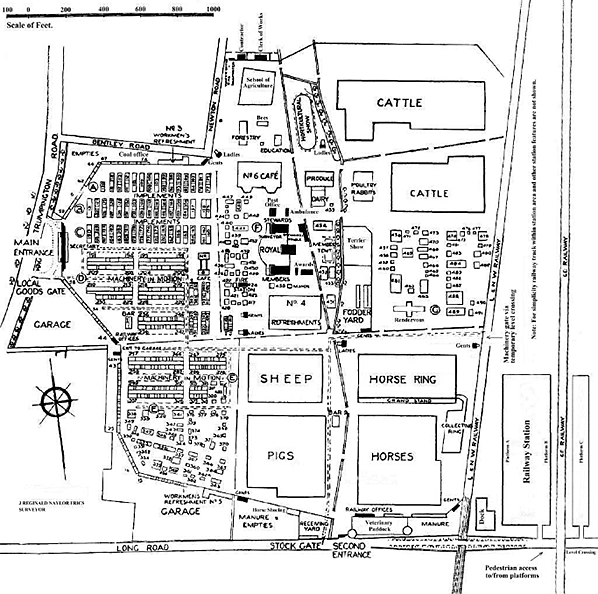
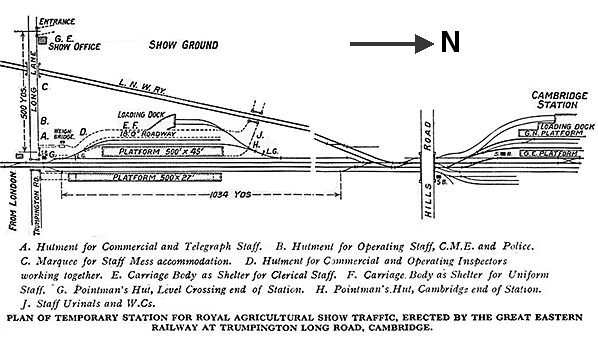
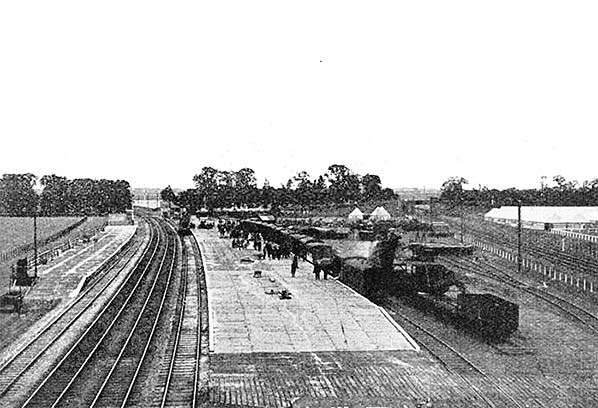
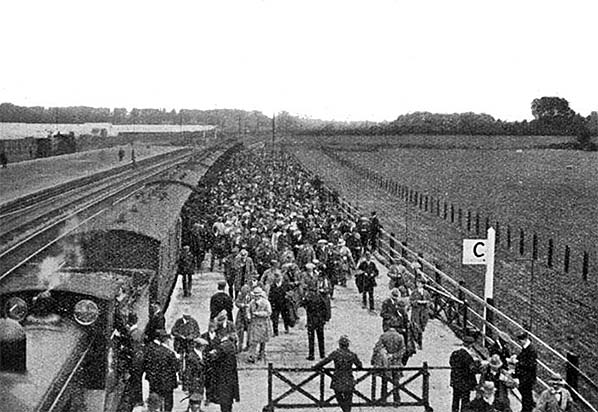
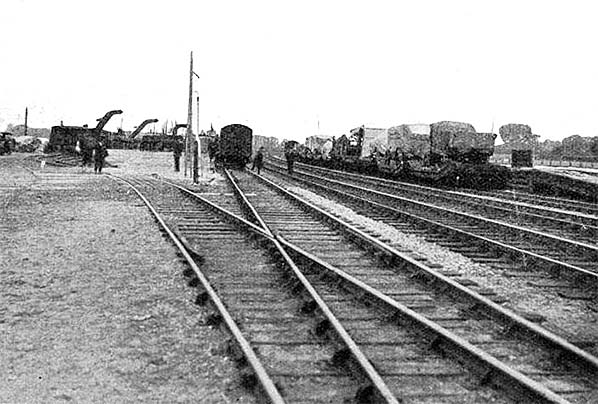
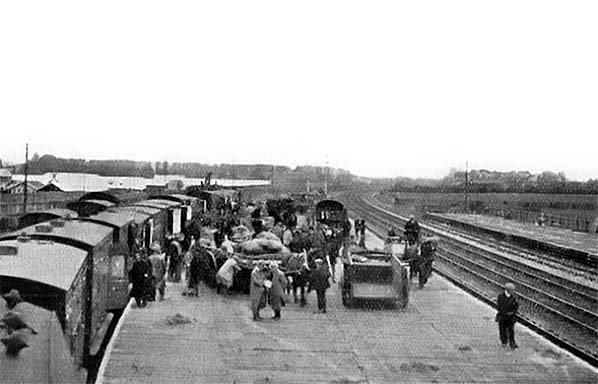
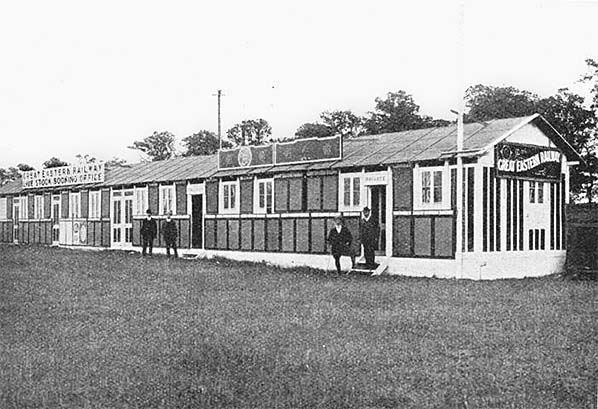


 The origin of this dinner ticket is something of a mystery in that at the time of writing it is not known if it dates from 1894 or 1922. There is nothing on its reverse face. It has been examined by a number of people knowledgeable in matters GER but without being able to date it conclusively. Nevertheless, it has been cautiously assumed to date from 1922 and the high ticket number might support this. The smaller 1894 show was quite remote from the railway, but the special platforms and siding facilities were located close to the station just north of Mill Road and this suggests most staff would have used canteen facilities at the station or even the engine shed which probably would not have required tickets. Even if they did, it is unlikely ticket numbers would have climbed as high as 1,599.
The origin of this dinner ticket is something of a mystery in that at the time of writing it is not known if it dates from 1894 or 1922. There is nothing on its reverse face. It has been examined by a number of people knowledgeable in matters GER but without being able to date it conclusively. Nevertheless, it has been cautiously assumed to date from 1922 and the high ticket number might support this. The smaller 1894 show was quite remote from the railway, but the special platforms and siding facilities were located close to the station just north of Mill Road and this suggests most staff would have used canteen facilities at the station or even the engine shed which probably would not have required tickets. Even if they did, it is unlikely ticket numbers would have climbed as high as 1,599.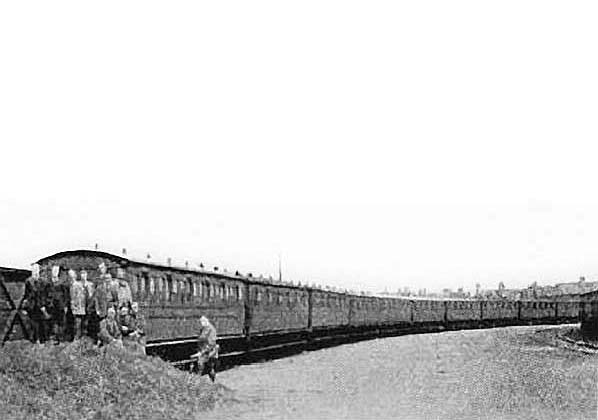
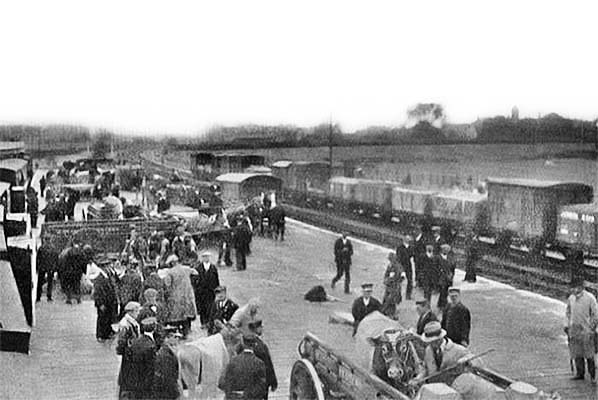
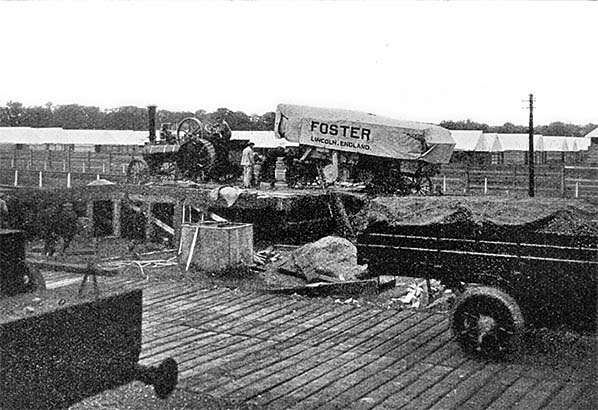
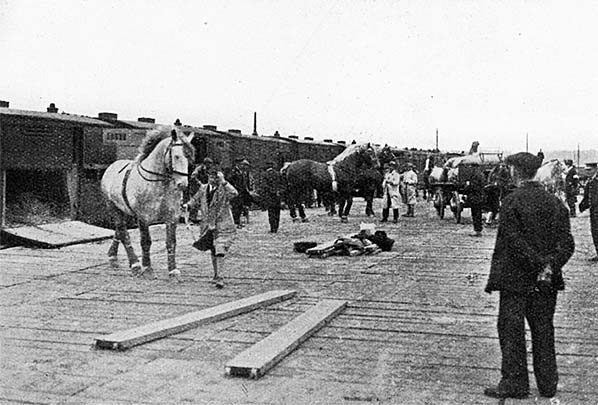
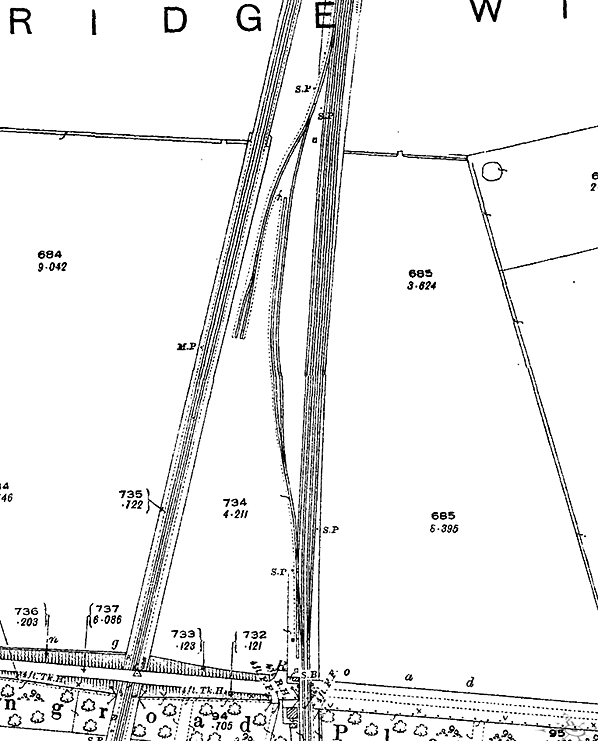
.jpg)
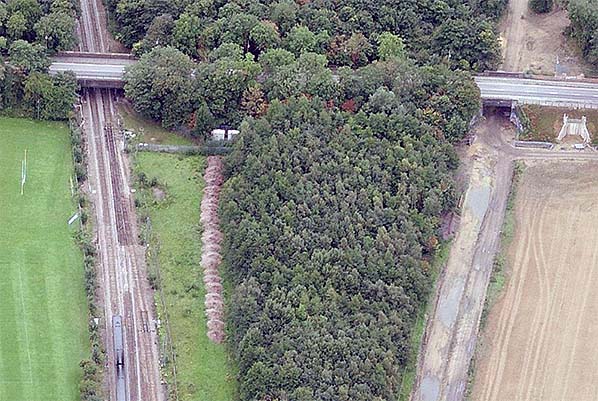

 Home Page
Home Page